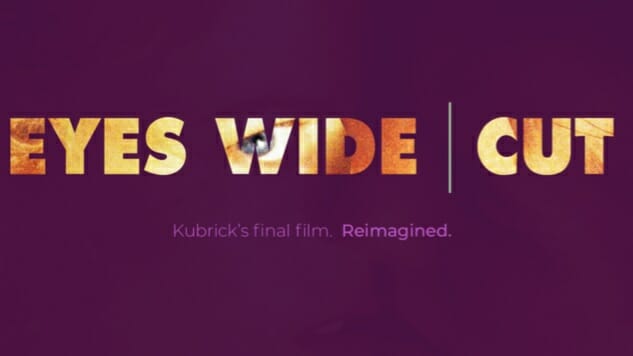
“Editing is the only unique aspect of filmmaking which does not resemble any other art form,” Stanley Kubrick said back in the 1970s. “It can make or break a film.”
The legendary director was known for completely changing his movies in the editing room at the last minute—or even after the first few screenings. Both 2001: A Space Odyssey and The Shining saw drastic cuts between the first showings and the official release.
But Kubrick died just six days after his first showing of his 14th and final film, Eyes Wide Shut, in 1999. (Steven Spielberg would finish the work Kubrick began on A.I. two years later.) Recently, actor/filmmaker Marshall Allman (Prison Break, True Blood, Humans) didn’t just wonder what a final Kubrick cut might have looked like had lived just a little bit longer. He proceeded to cut the film down himself.
The result is, of course, called Eyes Wide Cut, and is streaming at eyeswidecut.com.
(It’s worth mentioning that in 2015, Steven Soderbergh did much of the same thing, taking it upon himself to recut 2001 down to 110 minutes, excising its episodic structure as best as he could.)
We talked to Allman about the project earlier this month.
Paste Magazine: What inspired you to do this?
Marshall Allman: I was in London shooting Humans and in my downtime I was researching marriage in film for my film series Marriage (in Short), which led me to revisit Eyes Wide Shut. After watching, I started digging online and found some articles about the film possibly being left unfinished due to Kubrick’s passing. The more research I did, the more curious I became of what the “finished” version might have looked like and pretty soon my curiosity boiled over and I just decided to start cutting the film for fun. However, once I started, it began to sort of snowball and it honestly started to feel like the film wanted to be cut. Which is strange to say because it’s not like I was editing with absinthe in one hand and smelling salts in the other; it was just with every subsequent edit, new things would pop out to me and it felt like each cut just worked. Obviously there were some cuts that proved more difficult to make work technically speaking (music, SFX, etc.) but It was definitely surprising to me just how well the whole thing flowed.
Paste: When you were watching other Kubrick films, what did you notice about how he cut them down in subsequent releases?
Allman: Really, it comes down to the last-minute edits Kubrick made on 2001 and The Shining. With both of those films, Kubrick removed what you could call sort of explanations or resolutions, which in turn proved to give those films an element of enduring mystery that fans have obsessed over ever since. With Eyes Wide Shut, I believe there is a strong argument that Kubrick might’ve made similar edits to draw out the mystery of the story, especially when considering the scene with Sydney Pollack towards the end. It’s 14 minutes long and acts as a kind resolution—obfuscated yes—but a resolution nonetheless. Once you remove that scene it then begs the question of how much you actually need Ziegler [Pollack’s character] to tell the story. Which then raises the question: What is this film really about? A secret society that marionettes everyone through sex, money and media? Or a married couple on the brink of serious infidelity? Eyes Wide Cut is my answer to those questions.
However, with this “version” of the film, it obviously can not be said that “this is what Kubrick would’ve done.” In fact, if I had to put money on it, I don’t think he would’ve cut as much as I did, but rather the purpose of this is to help satisfy the “what if” left out there for us to ponder and I set out to satisfy that to its furthest end by answering, “What cuts are even possible?” I tried to my best to remove as much as I could without killing the essence of the original. What’s left is a version of the film that happens to address many of the early criticisms while hopefully still keeping the Kubrick fingerprint.
In the end, though, my favorite aspect of this whole project is the discussions that occur on our website. I am enjoying the debates and discussions with people who have seen the cut and weigh in with their opinions (positive or negative) and enjoy entertaining different interpretations and possibilities. It’s really fascinating to me as a film exercise and I think serves as a great testament to the many layers in Kubrick’s work and just how incredible of a filmmaker he was—what other filmmaker inspires like him?
Paste: What other projects are you working on now?
Allman: I’m finishing writing “A Tribulation,” part 2 of my film series Marriage (In Short) after our successful crowdfunding campaign, and should be shooting that this summer. I am also in post production on a documentary I directed with Foster The People. In pre-production on a feature about the UT Tower massacre in 1966. As an actor, I am in season 2 of Humans, the season finale of Chance on Hulu, NCIS earlier this month, and I recently made a fun cameo in the feature version of the “Thunder Road” short film by Jim Cummings.